Ballistic Studies on Fox-7 Based Triple Base Propellant for High Calibre Gun-Juniper Publishers
JUNIPER PUBLISHERS- ACADEMIC JOURNAL OF POLYMER SCIENCE
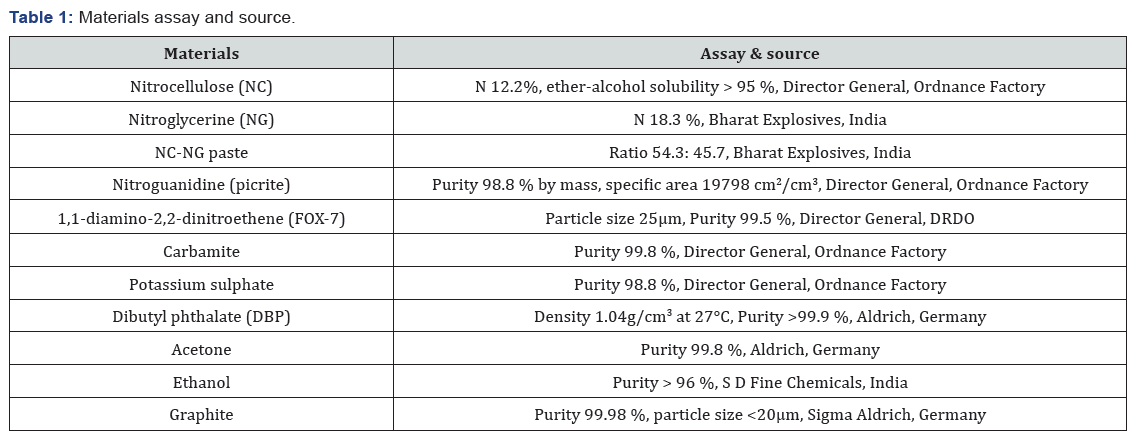

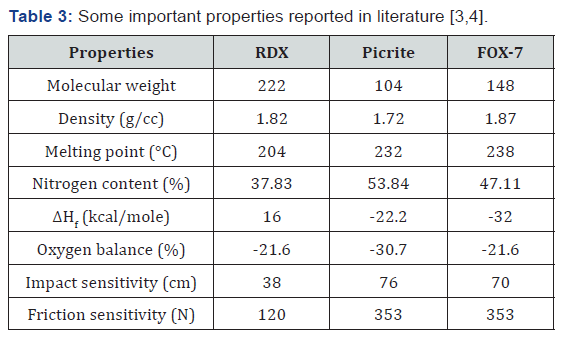
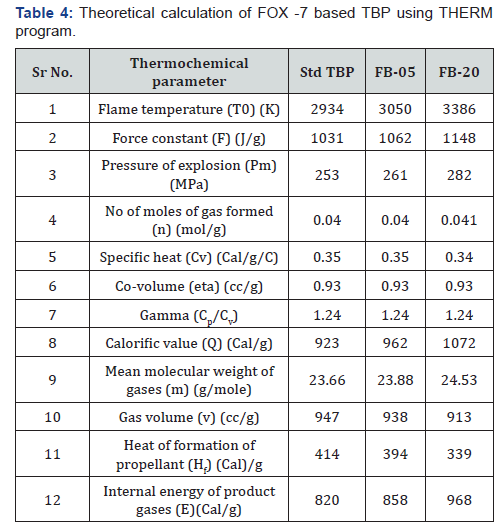



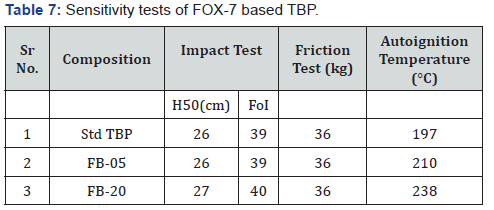
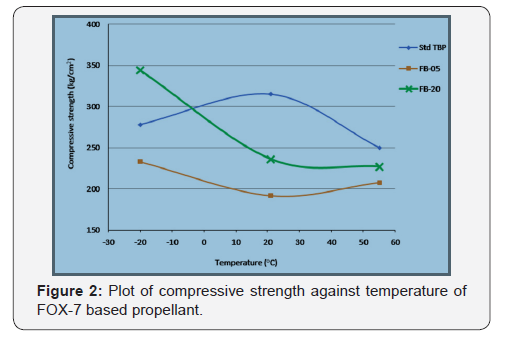
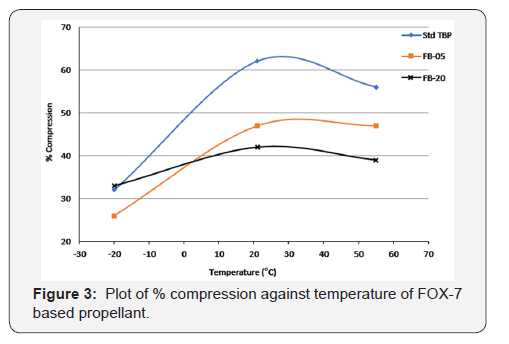
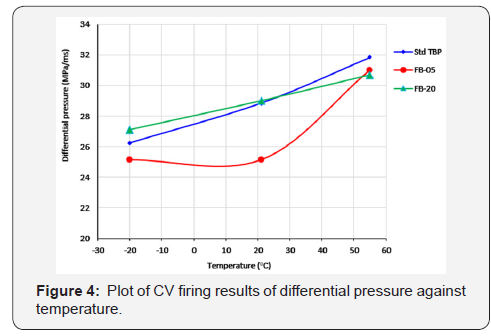
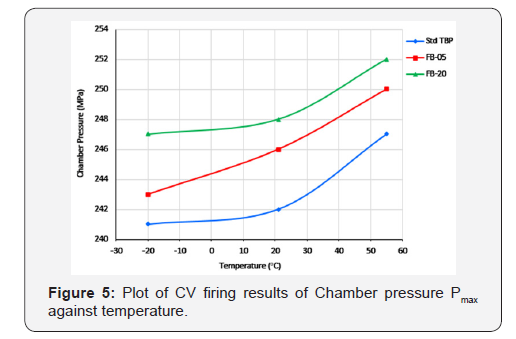
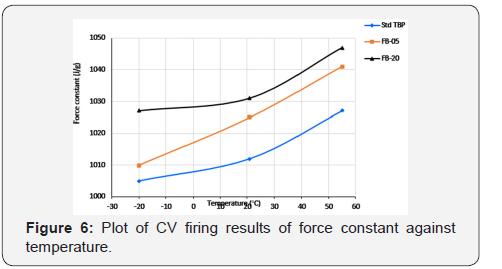
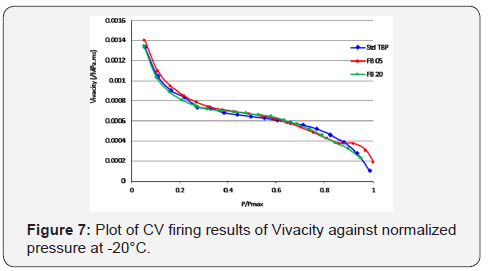
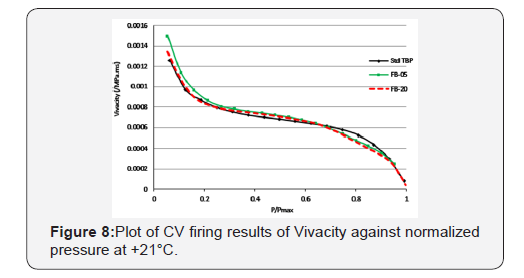
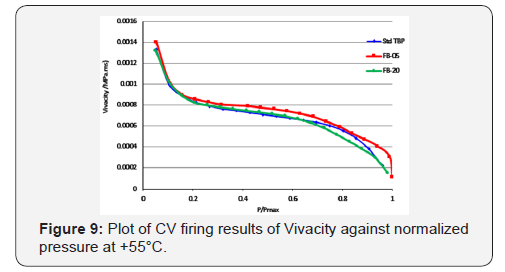
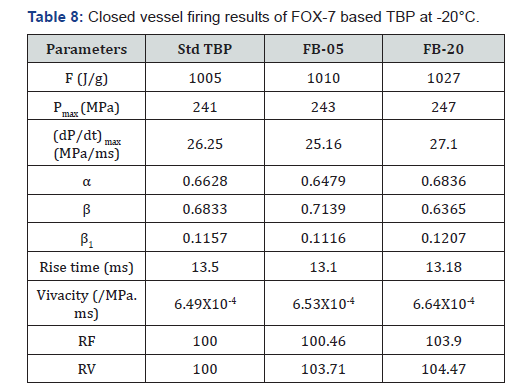
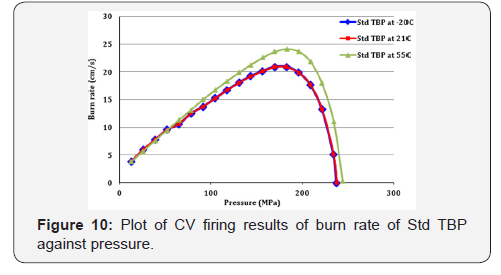
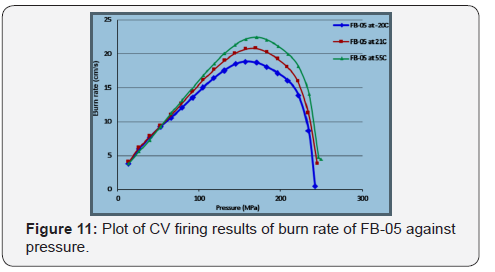
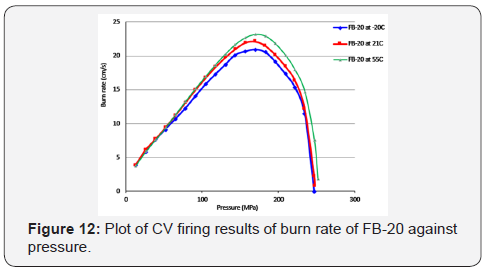
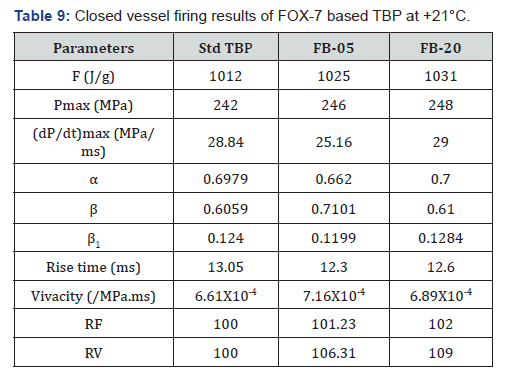
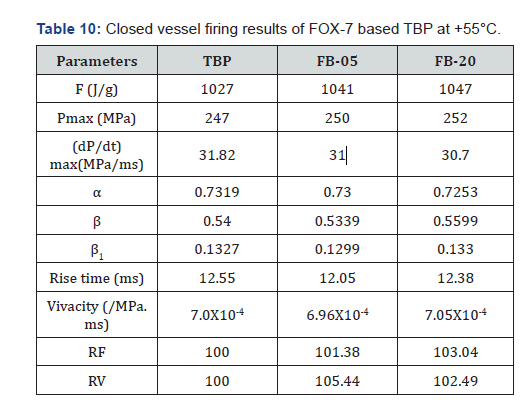
Abstract
In the present work, triple base propellant (TBP)
containing mainly energetic nitrate polymer nitrocellulose and
nitroglycerine, picrite, 1,1-diamino-2,2-dinitroethene (FOX-7) along
with ingredients such as stabiliser and plasticizer has been processed
by solvent method. Picrite has been replaced in increments with FOX-7
from the propellant composition. Acetone: ethanol used as solvent to
gelatinise/plasticize NC during processing. Dimensions of the propellant
was determined by physical measurement and propellant grains were
subjected to mechanical properties (compressive strength (CS), %
compression) determination, sensitivity tests and closed vessel (CV)
firing. Incorporation of FOX-7 led to remarkable increase in CS at
sub-zero temperatures (-20°C) and reduced at higher temperatures (+55°C)
for 20 % FOX-7 in TBP composition. CV test of the propellant was
carried out at 0.2g/cc loading density in 700cc closed vessel at +21,
-20 & +55°C to evaluate ballistic parameters such as Pmax, force
constant, (dP/dt) max, pressure index (α), burning rate coefficient (β),
rise time, relative force (RF) and relative vivacity (RV). The trends
observed during this work bring out the potential of FOX-7 to impart
temperature independent characteristics in the TBP used for high calibre
gun.
Keywords: FOX-7; Pressure index; Force constant; Burning rate; Chamber pressure
Introduction

FOX-7 or 1,1-diamino-2,2-dinitroethene (DADNE) as
reported by Lochert [1] is a low vulnerable energetic compound. It was
first synthesized in 1990s by the FOA Defence Research Establishment
(Sweden). However, its application in propellant has received attention
during last decade. The performance of FOX-7 is comparable to
cyclotrimethylene trinitramine (RDX) whereas its impact and friction
sensitivities are much less than that of RDX and other nitramines.
Calculated detonation velocity of FOX-7 based high
energy compositions has been of the order 9090m/s compared
to 8800m/s for RDX based compositions [1-3]. FOX-7 has a potential
for application in high performance IM-compliant explosive
formulations. Most of the research establishments working in the
area of high energy materials (HEMs) like Aeronautical and Maritime
Research Laboratory (AMRL) have focused on the synthesis,
hazards characterisation and performance evaluation of FOX-7.
Dorsett [4] has mentioned in the report that 1,1-diamino-2,2-dinitroethene
i.e. FOX-7 is like the insensitive chemical compound triamino
trinitro benzene (TATB), a benzene ring compound having
three amino and three nitro groups. FOX-7 has a two-carbon backbone
in place of a benzene ring, but the amino and nitro groups
have similar effects in both cases according to published reports
on sensitivity and chemical decay processes of FOX-7 [5] Table 1.

It is mainly produced by Eurenco Bofors AB & Sweden [1,6,7].
Some of the characteristics of FOX-7 vis-a-vis RDX and picrite are
given in Table 2. Various tests such as slow cook off, fast cook off,
bullet impact test have been conducted along with Composition
B to establish the insensitive nature of FOX-7 based propellants.
Most of the reported literature pertains to FOX-7 based plastic
bonded explosives. FOX-7 based compositions have undergone
deflagration (type V reaction) whereas, Composition B has given
detonation response (type I reaction). Burn rate (mm/s) was
found to increase with pressure (MPa) and force constant (J/g)
was found to increase with temperature.
Thus, FOX-7 enhanced the safety of propellant without much
compromise on propellant energy. Mishra et al [3] have also
studied lower vulnerability of FOX-7 based, non-aluminized and
aluminized, melt cast explosive with marginal decrease in performance
compared to RDX based compositions. S Karlsson [8] has
reported height of 50% explosion (H50) 63 - 79cm in Drop hammer
tests and no reaction in the friction test (>340 N). A castable composition
of FOX-7 and poly-glycidyl nitrate (Poly-GLYN) has also
been studied by these researchers. Limited safety tests indicated
that the compositions with FOX-7 were less sensitive to friction, it
had excellent thermal stability at 65°C and slow cook-off stimuli.
It did not detonate at a diameter of 25 mm and upon slow heating
(3.3°C/hour) it ignites at 220°C and burns without damage to the
container or the surroundings. Limited work has been reported
in literature on FOX-7 based propellant. Wuxi Xie et al. [9] studied
the performance of Nitrate Ester Plasticized Polyether (NEPE)
rocket propellants containing FOX-7 as replacement of Cyclotetramethylene
tetranitramine (HMX). They observed decrease in
combustion temperature by about 100K and increase in burning
rate as well as pressure exponents. Moreover, tensile strength of
the propellants was increased, whereas maximum elongation decreased
by about 40%. The initiation probability under pressure
decreased by 12% along with decrease in friction sensitivity of the
propellant suggesting improved insensitivity characteristics. Bogdan
Florczak [10] observed that, the propellant containing FOX-7
has a comparable deflagration temperature and gaseous reaction
products volume as the composite propellant containing the
same amount of HMX. Linear burn rate of propellant formulation
containing FOX-7 is nearly 17% less than that of the propellant
formulation containing HMX. Hendrik Lips et al. [11] has studied
FOX-7 / Ammonium perchlorate (AP) / Glycidyl Azide Polymer
(GAP) based rocket propellants for a shoulder launched projectile.
It is found that formulations containing FOX-7, AP and GAP
exhibit a plateau burning behaviour between pressure values of 7
and 12 MPa, like double base propellants. Chemical stability and
sensitivity test also within acceptable limits. FOX-7/ polyurethane
compositions with nitro plasticizers exhibit the best thermal stability.
Shock sensitivity test results of FOX-7 based propellant correspond
to values with a hazard division (HD) 1.3. However, the
mechanical properties need further improvement.
As limited studies are reported on FOX-7 based gun propellant,
the present work was undertaken to study FOX-7 as a component
of triple base gun propellant with NC as polymeric energetic
binder.
Experimental Section
Materials
NC-NG paste having volatile matter (VM) content 0.4% and
other ingredients weights are taken on dry weight basis for processing
the propellant batch. NC-NG paste, picrite and FOX-7 loaded
into incorporator for kneading and solvent (17-25%) along
with di-butyl phthalate to form homogenous and fully consistent
dough, warm water circulation started (38 - 40°C). Propellant processing
was carried out by well-established method. (Surjit Singh
Vol-II [12].
Chemical analysis of TBP was carried out using high
performance
liquid chromatography (HPLC) model No. Ultimate 3000.
This model of HPLC is manufactured by Dionex Softron GmbH,
Germering, Germany. The HPLC column has a neutral stationary
phase containing C18, octadecasilane with the dimensions of
250mm length, 4.6mm diameter and 5μm pore size. Mobile phase
included methanol: water (70:30) mixture. Propellant sample was
ground, and ether extract was prepared by heating the content in
water bath. It was injected into the HPLC column. The system is
run for a duration of 30 minutes by conditioning at a temperature
of 35°C at a standard flow rate of mobile phase of 1ml/min and
64 bar pressure in reverse phase. Content of polymeric binder NC,
graphite and K2SO4 in the propellant is calculated by difference. In
order to obtain only NC and graphite content in the propellant, the
residue of ether extract is treated with hot water. K2SO4 gets dissolved
in hot water that was estimated by well-known methods.
To estimate graphite, acetone is added in the remaining extract to
dissolve NC. Chemical analysis results are given below in Table 3.


Thermo chemical parameters for all the experimental propellant
compositions that is processed are calculated using THERM
program of HEMRL are given in Table 4. In this program, some
basic thermodynamic equations that are reported for gun propellant
combustion have been used for calculations [13-19]. Approximate
determination of temperature of explosion is carried
out using computer program. Then the calculation of heat of reaction
of gas and its internal energy is carried out. Number of gram
atom/gram of C, H, N, O are given by well-known and reported
equation. The energy released at 2500K is evaluated making use
of well-reported combustion parameters for C, H, N, O. The major
products of propellant combustion are predicted viz. CO2, H2O, H2,
N2 gases and dissociation products are OH, H, NO, O. Calculation of
internal energy of these gases is carried out by applying standard
thermodynamic equations. Thereafter, other important and quite
relevant constants such as co-volume, force constant and heat of
combustion are calculated and compared with values reported in
the literature. Detailed research work involving computer program
had been published by K P Rao [12]. Researchers have been
using this program widely for approximate calculation of ballistic
parameters pertaining to gun propellants [20-24].
Measurement of dimensions of dried propellant grain was
carried out using Vaiseshika Zoom Stereoscopic Microscope
Type 7004 TNC Sr. No. 99075 having resolution 7X to 60X manufactured
by M/s Vaiseshika Electronic Devices, Ambala Cantt,
Haryana, India. The propellant grain is held in different positions
under the microscope which is connected to a programmed computer
and image is frozen and thereafter various dimensions such
as web size, hole size, grain diameter, length etc. are measured in
mm by moving the crosswire from point to point in the frozen image.
Movement of crosswire across the image gives the length or
distance between the two selected points on the image that is displayed
and recorded by a programmed computer connected to the
microscope. Geometrical parameters of FOX 7 based TBP grains
are tabulated in Table 5. Photograph of a few propellant grains
taken using camera make Sony Japan. Model No. Cyber-shotDSC-
S980, 12.1 Mega pixel, Optical zoom 4X is placed at Figure 1.


Form function is a measure of surface area of the
propellant
grain and theoretical web factor (TWF) is the ratio of ballistic web
to geometric web is calculated using available computer program
[11,12]. Input parameters like grain geometry, hole size, diameter,
length: diameter ratio is given as input parameters for calculation
and form function and TWF are obtained as output parameters.
Mechanical properties testing was carried out using Hounsfield
Universal Testing Machine H25KN, New York, US. Length: diameter
(L/D) ratio of propellant grain was adjusted to 2.0 and conditioned at
+21, -20 & +55°C for 4 hours. Mechanical properties viz.
compressive strength (CS) and % compression of the propellant
grains was determined.
Impact sensitivity and test was carried out using BAM IM Fall
Hammer apparatus make Chilworth Technology, UK, with 2kg
drop weight. Friction sensitivity test was conducted using BAM FR
Friction test apparatus, make Chilworth Technology, UK. Similarly,
autoignition temperature was determined using Wood’s metal
bath. During all the three tests propellant sample was powdered
by grinding and 150-300μm particle size was taken evaluation
[6,25].
Closed vessel evaluation of FOX-7 based propellant along with
standard TBP (Std TBP) was carried out at 0.2g/cc loading density
in 700cc CV [26] after conditioning at +21, -20 & +55°C for 24
hours to determine ballistic parameters such as Pmax, force constant,
(dP/dt)max, pressure index (α), burning rate coefficient (β),
rise time, vivacity, relative force (RF) and relative vivacity (RV)
[19,27]. Measurement of pressure during CV firing was done using
tourmaline piezo-electric gauge. 1.2g gunpowder was used to
ignite the main propellant charge. Nearly 4 ampere current was
passed through a thin nichrome wire having length 22-25mm connected
across the firing electrodes closed vessel in order to ignite
the gunpowder which then ignites the propellant charge [28,29].
Results and Discussion
Chemical analysis results of TBP using HPLC is given in Table
2. Some important properties are reported from literature [3,4]. It
shows that FOX-7 has higher density and oxygen balance as compared
to picrite. Result of theoretical calculation (Table 4) shows
that, most of the parameters such as flame temperature, force
constant, chamber pressure, calorific value, and mean molecular
mass are increasing for FOX-7 based propellant compositions as
compared to standard TBP which do not contain FOX-7. Geometrical
parameters of propellant grains (Table 5) shows that web
size, hole size, diameter, length and form function for FOX-7 based
compositions grains are comparable to the Std TBP grains.

Mechanical properties such as compressive strength (CS) and
% compression after conditioning at +21, -20 & +55°C for four
hours are given in Table 6. The result shows that incorporation of
FOX-7 at 5% level bring down the CS whereas increase in FOX-7
content to 20% level results in improvement in CS at all the temperatures.
The CS at -20°C for 20% FOX-7 based composition is
more than that of even Std TBP. However, CS is increasing as the
amount of FOX-7 is increased in the propellant grain composition.
Incorporation of FOX-7 brought down the % compression at
+21°C. These results suggest that incorporation of FOX-7 renders
the TBP hard at sub-zero conditioning temperatures probably
due to reinforcement by FOX-7 particles involving physical forces
(hydrogen bonding). It is possible that microcracks may be developing
in the FOX-7 based TBP grains at sub-zero conditioning
temperatures offering greater burning surface resulting in combustion
stability and near to temperature independent ballistics
of gun propellant. This is on the lines of the work already reported.
The results also suggest that FOX-7 based TBP can retain structural
integrity even at higher temperature thereby preventing the
accidental damage to gun.



FOX-7 based propellant grains are stronger at -20oC
and weaker
at higher temperatures than Std TBP as the value of CS is higher
at sub-zero temperature and lower at +55°C. The performance at
+21 & +55°C is almost similar. Values of CS are plotted in Figure
2.Impact, friction as well as auto-ignition temperature test results
are given in Table 7. Auto-ignition test results bring out decrease
in vulnerability to thermal stimulus of propellant on incorporation
of FOX-7. These results are in line with the reported studies
Waldemar A. Trzciński [30]. FOX-7 did not have adverse effect
on impact and friction sensitivity of the propellant unlike RDX/
HMX. This may be due to stability gained by the molecules after
each oxygen atom of the nitro groups involved with two hydrogen
bonding in FOX-7 molecules resulting in two intra-molecular and
six inter-molecular hydrogen bonds [31] Figure 3.

As depicted in Figure 4, rate of change of pressure i.e. differential
pressure attains a maximum value for every composition
during CV firing is denoted in terms of (dP/dt)max. The value of
(dP/dt)max is lowered for FB-20 at +55°C whereas it is increased
at -20°C and almost coincides at 21°C with that of Std TBP. This
behaviour of FOX-7 based TBP indicates a trend towards low temperature
coefficient propellant.

Chamber pressure was found marginally higher for FB-05 and
FB-20 compositions compared to Std TBP evaluated during this
work at -20°C and 21°C, as shown in Figure 5 whereas it is found
to be marginally increased for FB-05 composition at +55°C. This
may be due to brittleness of FOX-7 based propellant composition
which gives rise to increase in surface area and increased burn
rate. Increased burn rate increases the amount of gases thereby
increasing the gaseous pressure. This trend in pressure indicated
that FOX 7 based TBPs are showing low temperature sensitivity
[32]. This result shows that FOX-7 based TBP can be used in large
calibre guns without hazards.

Force constant which is a measure of propellant energy is almost
same for FB-20 composition at -20°C and at 21°C as compared
to Std TBP and FB-05 composition whereas it is increased
at +55°C. The graph is plotted in Figure 6. This behaviour of FOX-7
based TBP indicates a trend towards low temperature coefficient
propellant in sub-zero temperature region. This may be due to
hardening of FOX-7 based propellant grain making it more brittle
propellant composition which gives rise in surface area and
increased burn rate. Increased burn rate increases flame temperature
and gaseous molecules move faster giving more force
or energy (Table 4) [30]. CV firing results bring out increase in
force constant with increase in FOX-7 content in the propellant at
replacement of picrite. This may be attributed to higher density
and superior oxygen balance (stoichiometry) of FOX-7 compared
to picrite.

Dynamic vivacity expressed as [(1/P). (1/Pmax). (dP/dt)] is
plotted against normalized pressure (P/Pmax). A comparison of
Figure 7-9 corresponding to CV tests at -20, +21 and +55°C respectively
shows that graph of vivacity for FB-20 composition begins
on the lower side as compared to FB-05 and marginally higher
than Std TBP and it remains on the lower side for entire range
of normalized pressure. It indicates comparative lowering of the
production of gases at all temperatures of conditioning for FB-20
propellant composition and particularly at +55°C. This clearly
brings out the fact that FOX-7 based propellant composition has
the potential for exhibiting low temperature coefficient ballistic
parameters. Similar is the trend in case of RV as observed from the
graph between RV versus temperature shown in Table 8.




Burn rate versus pressure profile obtained during CV firing
of FOX-7 based propellant compositions at -20, 21 & +55°C respectively
plotted in Figure 10-12. Graph shows that burn rate
increases with increase of temperature and attains peak at certain
pressure and then falls off steeply even though the pressure increases
as the propellant gets consumed fully. It may be noted that
the burn rate is lowered as the FOX-7 content is increased in the
propellant compositions. Burn rate for FOX-7 based composition
FB-05 is reduced as compared to Std TBP; however, for FB-20 it
was close to that for Std TBP at -20°C whereas at +55°C for FOX-7
based composition gave marginally lower burn rates at Pmax compared
to Std TBP. These results are indicative of introduction of
temperature independent/less dependent combustion of FOX-7
based TBP. It increases the duration of combustion. This indicates
that pressure may act on the base of projectile for a longer duration
increasing its velocity [Table 9 & 10].




Conclusion
FOX-7 based gun propellant has given improved energetics
and ballistic properties as compared to conventional TBP. Force
constant, Pmax, (dP/dt)max, and RV are on the higher side as compared
to standard TBP propellant showing that loading density in
high caliber gun can be reduced to get the same muzzle velocity
and chamber pressure. Vivacity variation indicates lowering the
production of gases at all temperatures of conditioning of the FB-
20 propellant composition and the rate of generation of gases is
further lowered at higher temperatures as compared to Std TBP.
This clearly brings out the fact that FB-20 propellant composition
has the potential for exhibiting low temperature coefficient ballistic
parameters. Similar trend is observed in case of RV versus
temperature. Burn rate is lowered and the peak is broadened as
the FOX-7 content is increased in the propellant compositions
indicating increased duration of combustion. This indicates that
pressure may act on the base of projectile for a longer duration
increasing its velocity. The trends in ballistics observed bring out
the fact that FOX-7 has potential to impart less sensitive, temperature
independent characteristics in the TBP used for high calibre
gun.
For more Open Access Journals in Juniper Publishers please
click on: https://juniperpublishers.com
For more articles in Academic Journal of Polymer Science please
click on:https://juniperpublishers.com/ajop/index.php
For more Open Access Journals please
click on: https://juniperpublishers.com

Comments
Post a Comment